Category Archives for Execution
True Leadership Feels Like Dragging People Kicking & Screaming

If you aren’t constantly dragging your employees or direct reports towards excellence, faster execution, and continuous improvement then you will notice that they will eventually default back to status quo, being average, and remaining in their comfort zone. It’s why there are very few true leaders in this world while the rest are just along for the ride, who buy things like lottery tickets, all because they truly want the easy path. Which is why as a leader, you have two choices. You either drag your people forward with high energy and push them into a constant state of continuous improvement, or watch them default back to their own, average, status quo. If you drag them forward, you will have a chance at achieving excellence in your company or department. But if you leave them to their own devices, you will achieve nothing more than their “average”.
But you aren’t doing this to be average, right? Exactly. So, as a leader you need to be very careful with words like “autonomy”. Like anything, “autonomy” given without this flavor of leadership can result in status quo performance.
Leaders are intrinsically motivated to work hard, pursue excellence, and completely reject the status quo. It’s who we are. But its equally as important to know that this is not who everyone else is. Therefore, when you are really leading it should feel like you are making people feel uncomfortable. They should feel like they are doing things and are being challenged in ways never experienced before. To you, it should feel like you are dragging them to a point of almost kicking and screaming.
If it doesn’t feel this way right now, then you aren’t setting the bar high enough. As such, you aren’t moving as fast as you could be and time is a wastin’. So go set it higher. Right now.
Embrace that Your Assumptions will be Wrong

Once you embrace that your assumptions about your customer will almost always be wrong, you realize that launching faster is far more important than trying to get it perfect upfront. The marketplace is the ultimate truth. Only after you launch will you get real feedback from real customers. Which means that within days, you will learn that several — if not many — of your upfront assumptions were wrong.
Once you realize this, you can start to see that it is a complete waste to allow yourself, or your teams, to spend tons of extra time and resources trying to make something “perfect” and allowing “perfect” to delay your launch. It’s literally money and resources flushed down the toilet, because you don’t know what perfect is yet. BUT — what I am willing to bet, is that YOU DO KNOW what is “80% perfect” right now and you can get that to market quickly. So, your job as the CEO of your world is to define what is 80% perfect and then push everyone to get that product or feature to market (even as a small, controlled beta test) as quickly as possible.
Have you ever noticed or tracked how expensive the remaining 20% of any feature, project, or product is? I have. I have been a part of too many projects where a team will get 80% done in one day, yet it takes an extra 30 days just to complete that last 20% of perfection. I’m sure you have too. It’s those projects that just linger and never get done. It’s those projects that randomly pop in your head and you immediately think WTF why is that not done yet, and then you step in and realize everyone has been overcomplicating it. They are overcomplicating it because they are banking on their assumptions. They want to be right and are scared to be wrong.
So I encourage you to take stock right now of any product, feature, or project you are working on — especially those that seem to be dragging on. Find the 80/20 in it, and I’m willing to bet you can get it completed in 1-2 days. More importantly, teach everyone on your team to embrace that their assumptions will always be wrong, so will yours, and that this is just a fact of business. It’s nothing to get emotional about. Doing this will create a culture based on fast execution, getting to market quickly, and collecting customer feedback as the way to ultimately achieve perfection.
Early On, Do Things That Don’t Scale
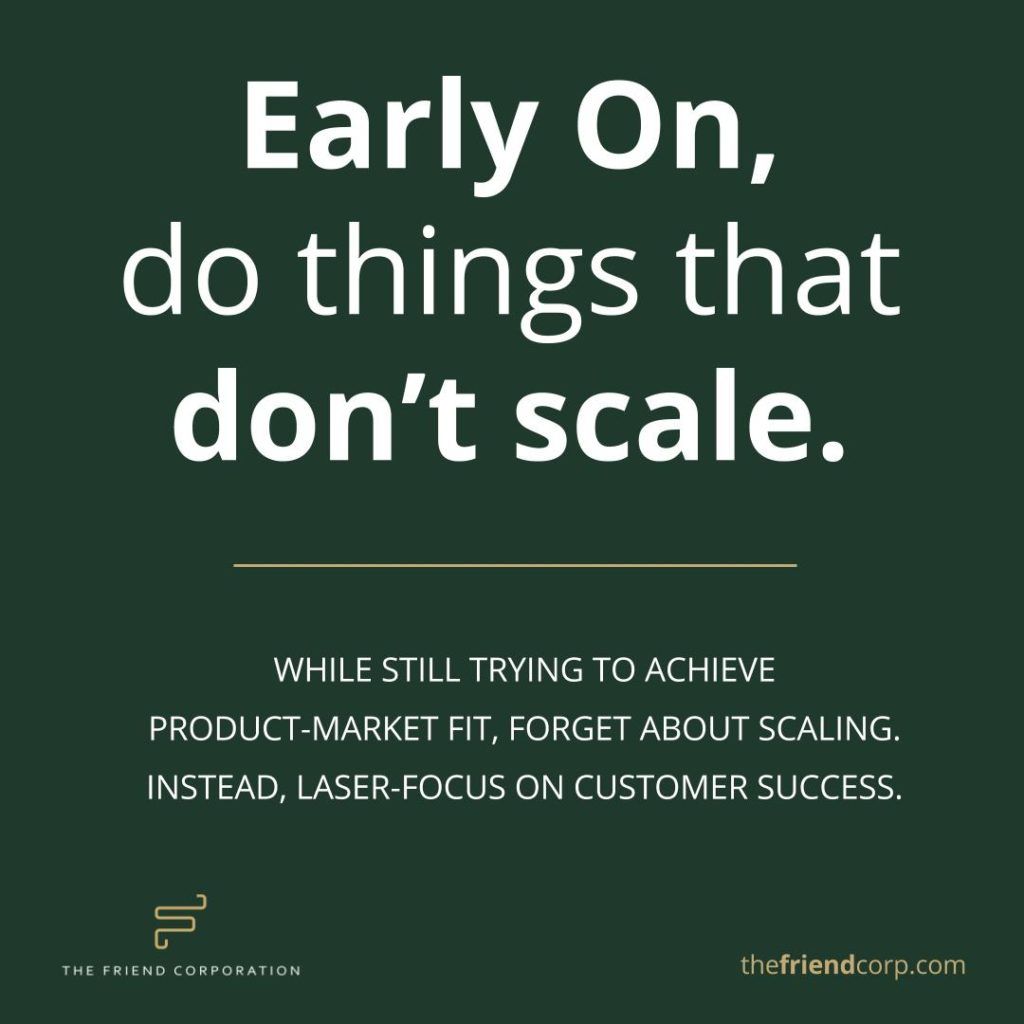
When you start out, or your revenues are below $2 million, “scaling” is not a priority – yet. Still, I hear this all time: “I can’t do x, because it won’t scale!”. While you are still trying to achieve product-market fit, the words “but that doesn’t scale” shouldn’t ever cross your mind. You just need to attack and solve problems, irrespective of scale.
Even if that means calling every one of your first 50 customers to make sure they are successful with your product. Even if that means doing a highly manual, labor-intensive process up front. Even if that means the CEO is handling 50% of the support tickets up front.
Your primary job is to find a way to make your product fit, and to make your customers successful, or frankly you won’t be around much longer. Yes, it will cost you more to do so — you may have to overstaff, you may have to spend hours on things that suck and that you didn’t plan on doing.
But the truth is that it will take multiple iterations before you figure out what actually works and makes your customers happy and successful. Which is why it is a complete waste of time to talk about what will or will not scale up front. You don’t even know what you really need to be doing yet! Once you actually go through the iterative process and figure this out — THEN you can figure out how to scale it.
Trust me, this may be hard to see now. You may be tempted NOT to do something because you “know” right now it won’t scale. Don’t fall for it. Solve problems first, scale after. Once you know exactly what you need to do, you WILL come up with creative solutions on how to scale it. You’ll look back and be relieved that you didn’t get in your own way.
Check out this post from Paul Graham of Y Combinator how billion dollar companies like AirBnB and Stripe did things that didn’t scale early on.
Your Business is a Machine that Produces Outcomes
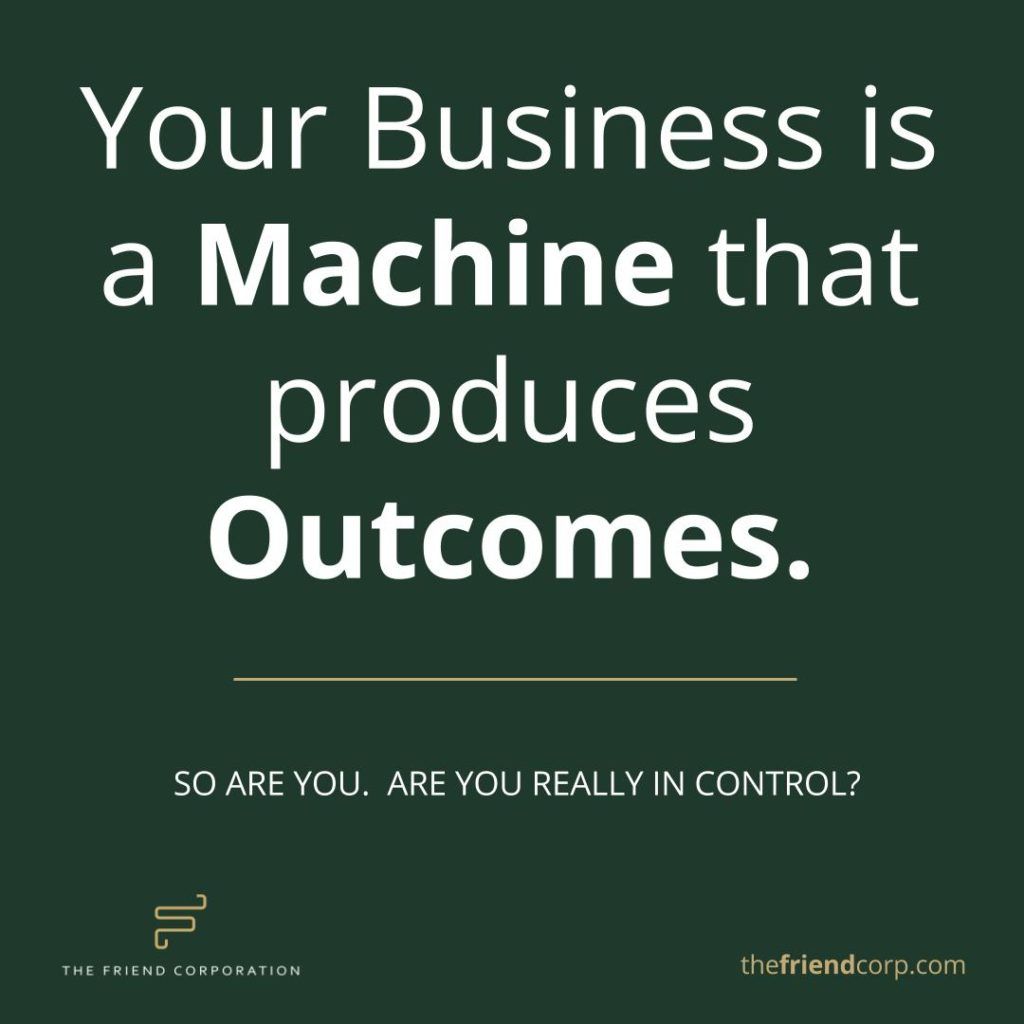
Whether you realize it or not, your personal output today will one based on your biases, assumptions, patterns, and execution. You yourself are a machine that produces outcomes. You can change those outcomes by analyzing the way you do things and think about things and disrupting your patterns. The current state of your machine might be designed to make you poor. Or rich. Or healthy/unhealthy, fulfilled/unfulfilled.
The same goes for your business or wherever you work. The business is a machine, and it produces outcomes based on the way it is managed by leadership in all departments. Each person in the company, all of your current systems and processes define the current state of your machine. The machine should result in the production of happy customers and promoters, among other things. In its current state, is your business designed to do that? Or, what is it designed to produce in its current state….chaos? Mistakes? Bad culture?
Start thinking about your business like a machine that produces outcomes. And then you will realize that your role is to be an engineer every day, continuously improving the machine’s current state.
Only what is Measured will Improve
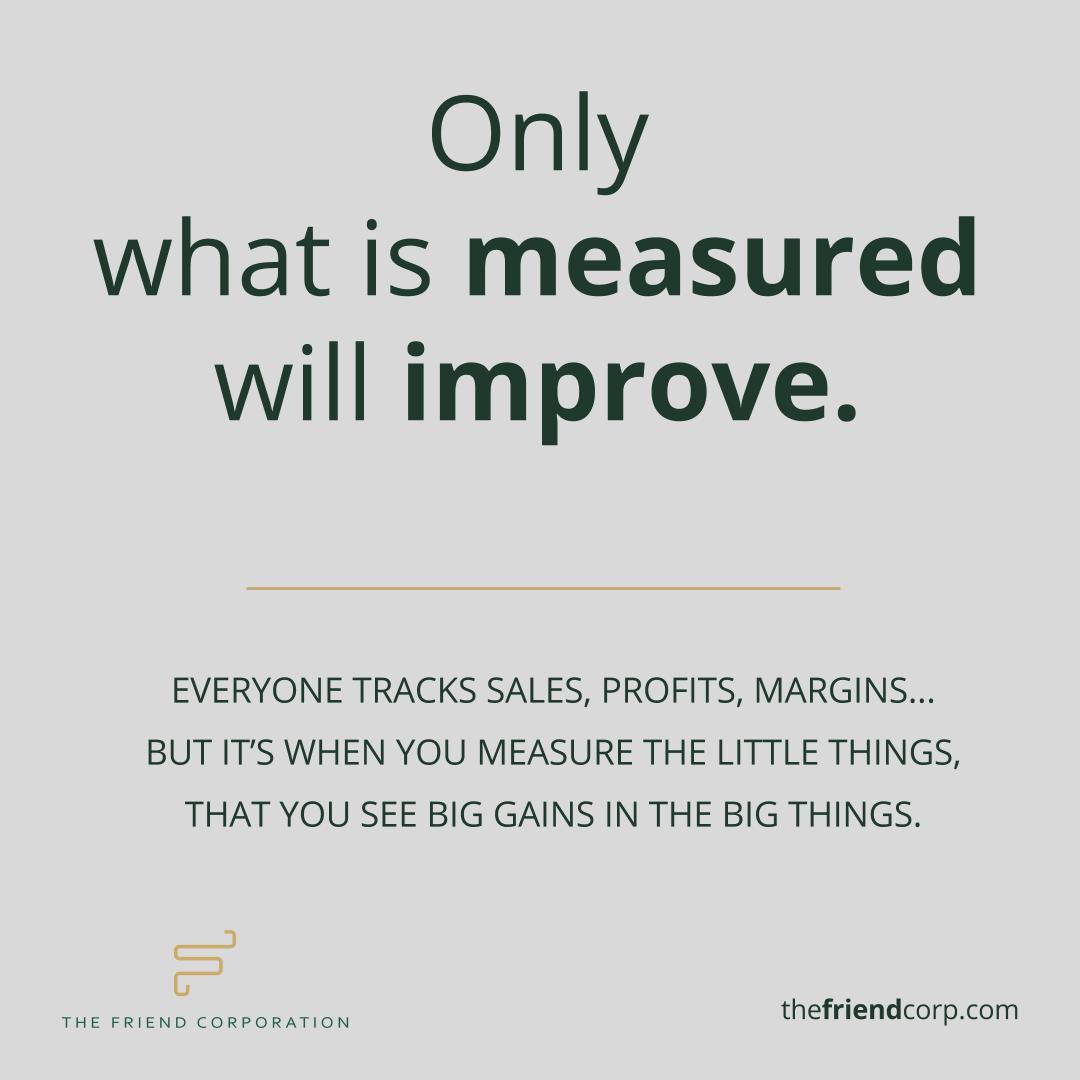
Yes, you probably manage your sales numbers, margins, NPS, and other top-level KPI’s (Key Performance Indicators). But there are always sub-metrics that DRIVE any top-level KPI. I call them supportive KPI’s, and your job as a CEO is to identify them and get measurement reporting in place for them. It’s easy, and once you have done it, you will immediately improve almost any aspect of your business.
For example, in customer satisfaction a top-level KPI you should be using is Net Promoter Score (NPS). But if you go and tell your team to “go improve NPS” they will surely implement things but you will have to wait a long time to find out if those things really worked. Often times, they won’t, and you just wasted a ton of time. What you want to do is identify Supportive KPI’s that can be measured daily/weekly and that are visible to all team members working on it. Some of these I have identified that you should consider — daily/weekly customer satisfaction ratings, the # of positive reviews received as a percentage of support tickets handed, and # of customer referrals received. If you see the Supportive KPI’s improve on a daily/weekly basis, then you can be confident that the top-level KPI will improve and so can your team.
Apply this top-level/Supportive KPI framework to every department and your business, and your business will start rocking. Once you truly identify and measure everything that really matters and you will immediately know whether every department is headed in the right or wrong direction.
Only what is measured will improve.
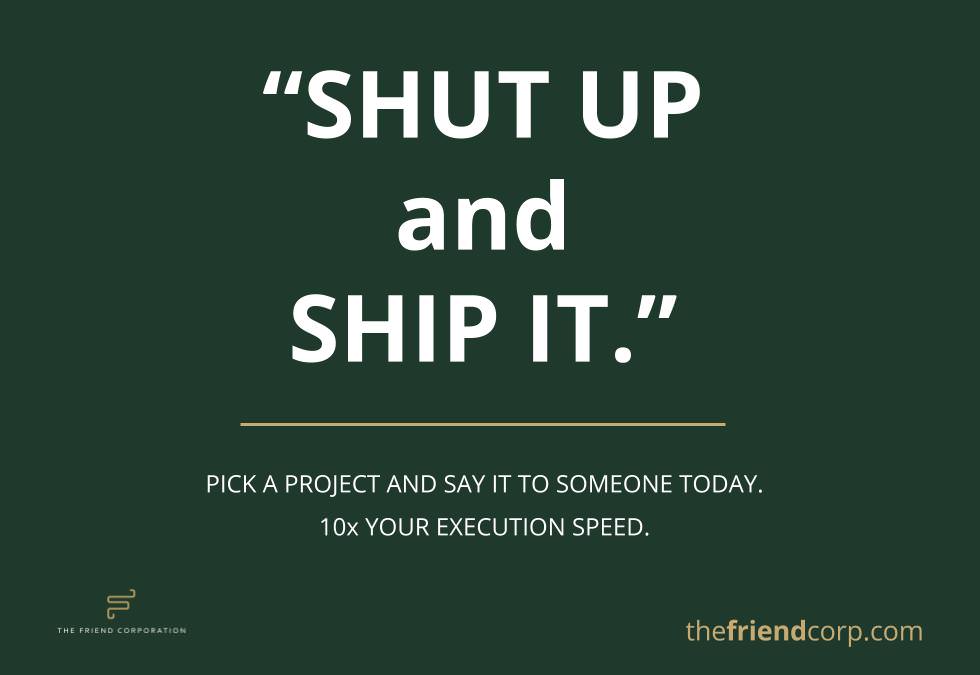
Shut Up and Ship It.
The faster you ship, the more experiments you run, the faster you learn what is working and what is not, the faster you iterate and the faster you get to actually solving a problem for your customer. You don’t know what the customer really wants anyways until you get it out there.
So shut down all the excuses, don’t be a perfectionist and find the fastest way to finish the project you are working on today and just fucking ship it.
The same way we shipped the first version of The Friend Corp website and this Instagram account. They weren’t ready and I didn’t care. I launched and now I’m already learning and adapting.
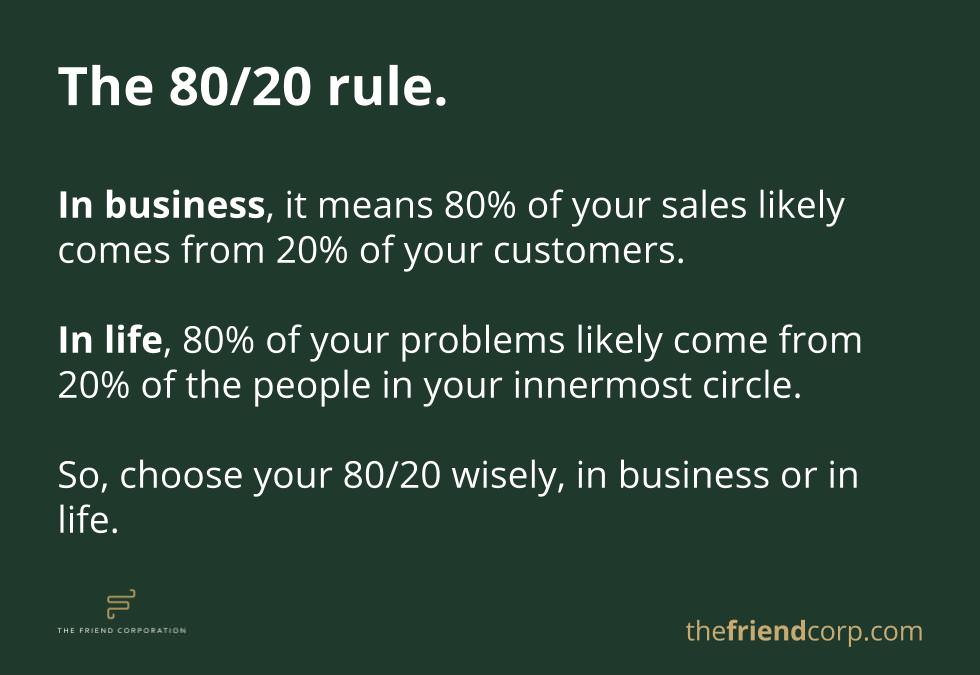
The 80/20 Rule Rant
80/20.
Also called “the Pareto Principle,” it is something I have relied on heavily to build companies but is also applicable to any aspect of life.
In business, 80% of your sales will come from 20% of your customers. 80% of your organization’s effectiveness will come from 20% of your talent.
In life, 80% of your problems will come from 20% of the people in your innermost circle. Likewise, 80% of your happiness will come from 20% of the people in your innermost circle.
Choose your 80/20 wisely, in business or in life. It will make a big difference.